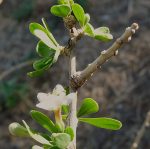 Also called European tea-tree, this deciduous shrub native to Mediterranean shrublands, is a member of the nightshade family, Solonaceae, that also includes tomato, eggplant, and tobacco. The spreading many branched plant grows up to 13′ tall and has an extensive root system and light brown hairless stems that darken and becomse fissured as it mature. The stems have spines up to 3/4-6″ long , depending on age, and each small side branch ends with a spine. The lanceolate leaves are alternate, entire, and 3/4-2″ long. The fragrant, tubular flowers usually appear singly in summer. They have 5 lobes and are pink, violet or greenish-yellow. The 1/3″ wide fruit is a red or orange fleshy berry that may have medicinal value. The extensive root system of the plant makes it useful for soil stabilization projects and its maritme tolerance makes it useful for coastal gardens. The genus name, Lycium, comes from the name of an ancient city in Asia Minor and was used by the ancient Greeks and Romans for some thorny shrub or tree. The specific epithet, europaenum, suggests the distribution of the plant in Europe.
Also called European tea-tree, this deciduous shrub native to Mediterranean shrublands, is a member of the nightshade family, Solonaceae, that also includes tomato, eggplant, and tobacco. The spreading many branched plant grows up to 13′ tall and has an extensive root system and light brown hairless stems that darken and becomse fissured as it mature. The stems have spines up to 3/4-6″ long , depending on age, and each small side branch ends with a spine. The lanceolate leaves are alternate, entire, and 3/4-2″ long. The fragrant, tubular flowers usually appear singly in summer. They have 5 lobes and are pink, violet or greenish-yellow. The 1/3″ wide fruit is a red or orange fleshy berry that may have medicinal value. The extensive root system of the plant makes it useful for soil stabilization projects and its maritme tolerance makes it useful for coastal gardens. The genus name, Lycium, comes from the name of an ancient city in Asia Minor and was used by the ancient Greeks and Romans for some thorny shrub or tree. The specific epithet, europaenum, suggests the distribution of the plant in Europe.
Type: Deciduous shrub
Outstanding Feature: Soil stabilization, potential medicinal value of fruit
Form: Rounded
Growth Rate: Moderate
Bloom: Tubular, pink, laender, green-yellowish all summer
Size: 13′ H x 14′ W
Light:Full sun
Soil: average, moist, well-drained soil but tolerates lean soil and maritime exposure
Hardiness: Zones 8-11
Care: Pinch to encourage bushiness
Pests and Diseases: None of significance
Propagation: Seed, half-ripe cuttings in summer and mature cuttings from autumn to late winter, layering, and division.
Photo Credit: Wikipedia